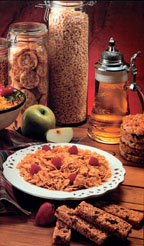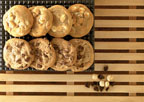

Type 1, Type 2—Togetherness and Poles Apart
Two primary forms of diabetes exist: Type 1 and Type 2. Typically, Type 1 occurs most often during childhood or young adulthood and is characterized by the body's inability to produce insulin. Insulin is required for cellular uptake and subsequent metabolism of glucose—the body's preferred energy source. Relative insulin insufficiency or insulin resistance, a condition that occurs when the cells cannot efficiently absorb glucose, characterizes Type 2 diabetes. The predominant cause of insulin resistance is obesity.
For Type 1 individuals, the onset of uncontrolled diabetes is rapidly apparent and can lead to medical emergency situations. For people with Type 2 diabetes, the disease may go undetected until diagnosed in association with a variety of medical symptoms. In both cases, unmanaged diabetes can lead to cardiovascular disease, renal disease, blindness, peripheral neuropathies leading to amputations and, ultimately, death.
Managing the Silent Killer
Diabetes requires a team management approach combining medical, nutrition and lifestyle factors. General nutrition approaches (or Medical Nutrition Therapy—MNT) focus on maintaining normal blood glucose (BG) and lipid profiles, managing blood pressure and making healthy, balanced food choices. For Type 2 diabetes, weight loss and increased physical activity are primary goals.Comprising sugars, starch and fiber, carbohydrates play the most important role in diabetes management. The amount and type of carbohydrate ingested, as well as the form in which it is eaten, and with what it is eaten, manifests itself in plasma BG readings two to four hours later. The nutrition goal is either to correctly supply the body with the appropriate amount of insulin to counteract BG levels (Type 1), or to make existing insulin more potent via weight loss and physical activity (Type 2). The American Diabetes Association advocates a dietary approach which manages the total number of carbohydrates ingested. An alternate emerging approach monitors the glycemic index of foods—the extent to which different carbohydrate-containing foods affect BG levels and subsequent insulin levels.
Beyond carbohydrates, the dietary management plan is not clear-cut. Cardiovascular disease (CVD) is the primary cause of death for diabetics. Unmanaged BG can result in abnormal blood lipid profiles that are consistent with CVD. Diabetes Medical Nutrition Therapy advocates a reduced total fat/saturated fat diet, with monounsaturated fat being the preferred fat to replace other forms of dietary fat. Monounsaturated fat, specifically in its cis-form, can lower plasma LDL-cholesterol. Since hypertension is an underlying contributor to CVD and is correlated with obesity, a precursor to Type 2 diabetes, managing appropriate micronutrient intake such as sodium, potassium, magnesium and calcium also is critical. And don't forget calories! For Type 1 diabetes, ingesting sufficient calories is the goal. For Type 2 diabetes, avoiding excess calories is the goal.
Where to Begin?
There are possibly two approaches. One can either pick a target goal such as weight loss or a reduced fat diet or, choose comprehensive general health products that cover several bases for the consumer with diabetes.Hope Warshaw, a registered dietitian and author of The Diabetes Food and Nutrition Bible, says this about product formulations for diabetes: “First of all, we need to pull apart pre-conceived notions about diabetes and food. Diabetes does not mean sugar free, or can't have sugar. For the majority of people, obesity is the issue and, therefore, product formulations focusing on fewer calories would probably be more suitable.” Warshaw feels sugar-free products can create false illusions. The former approach to diabetes dietary management was avoidance of concentrated forms of sugar. Consumers, therefore, chose products with reduced or sugar-free compositions. But sugar-free does not mean calorie-free. According to Warshaw, products containing sugar replacements have a role for the diabetic consumer, but that role is a small piece in a much larger dietary puzzle.
“No one is looking for a specific product in my research group, as I believe that there is no magic pill,” says Michael Leidig, R.D., clinical research coordinator at Children's Hospital, Boston, and a proponent of the Glycemic Index (GI) approach. “But, consumers are looking for products specific to their situation, such as reduced calorie, reduced fat, or low GI.” Leidig suggests an optimal product may comprise a low GI cereal incorporating whole grain kernels and ground flax seeds, possibly fortified with calcium, potassium, magnesium, and vitamin E, served with fresh fruit and low-fat milk.
Pamela Eltmant, managing director of Product Dynamics, a division of RQA Inc., encourages the continued formulation of low fat, sugar-free products. “These products provide consumers with choices.” Given the nutritional dynamics and challenges of diabetes, she also is supportive of a food certification program similar to that of the American Heart Association that would provide the consumer with diabetes-friendly product recommendations. While the American Diabetes Association offers no direct product endorsements, it does provide consumers with package-based guidance via its Exchange Verification Program. Products meeting meal planning exchange criteria devised by the American Diabetes Association and the American Dietetic Association may carry a standard tagline on their packaging.
The diabetes market remains viable for sugar-free and sugar replacement products. The burgeoning diabetic population also represents a new marketing niche for products targeting those focused on weight management or heart health. And for producers of fruits and vegetables, this is prime time.
Sidebar
A stabilizing and texturizing system, Meyprogen™ MS-113, has been developed for a variety of sauce products. MS-113 is a very versatile system, providing a smooth texture and excellent cling at a low cost in use. Additionally, MS-113 can be used in shelf-stable, refrigerated or even in frozen entrée sauces. Rhodia Inc., 800-343-8324
A pregelatinized wheat starch that has applications in almost any product from bakery products to gravies, soups and sauces to salad dressings, Pregel™ 46 is new on the market. This high-viscosity starch hydrates quickly, possesses good freeze-thaw stability, and helps control grain, cell texture and volume in bakery mixes. Call for more information on the company's premium wheat starches and wheat proteins. Midwest Grain, Selma Key, 800-255-0302, ext. 3276, selmak@midwestgrain.com.
This company's lactose is highly regarded for its consistency, purity and clarity. Proliant natural, fine grind and extra-fine grind lactose is a free-flowing pure reducing sugar that can be used in a variety of finished food products. Proliant Inc., Jody Baxter, 800-360-2672, jody.baxter@proliantinc.com
Ground-breaking nutritional and functional properties can be added to foodstuffs with soluble, all-natural RAFTILINE® (inulin), RAFTILOSE® (oligofructose) and Synergy 1. Benefits include improved calcium absorption, “invisible” fiber enrichment and enhanced GI health through prebiotics. Synergy 1 enhances calcium absorption at lower use levels. Orafti North America Inc., Kathy Niness, 610-889-9828, Kniness@orafti-us.com
Native starches and modified cook-up starches are, in most cases, practical and pragmatic solutions for food products in which heating or cooking is a necessary part of product formulation and processing. However, when the primary reason for cooking is hydration of the starch itself, the use of instant starches can offer both convenience and, often, the elimination of an entire processing step. This results in significant savings in time, labor, energy, and equipment, as well as improvement in delicate products normally subjected to heat. Tate & Lyle/A.E. Staley Manufacturing Co., Gary Augustine, 800-526-5728 or 217-423-4411
Sugar provides texture and color while enhancing the flavor of foods. It also acts as a bulking agent and preservative, and balances food acidity. United Sugars Corporation is a supplier of refined beet and cane sugars to the nation's top food producers. United Sugars Corporation, Jan Blake, 952-896-0131, jblake@unitedsugars.com
Crystalline fructose has applications in several products, including beverages, baking products, fruit preparations, yogurts, and reduced-calorie foods. ADM's Crystalline Fructose is a white, free-flowing crystal sweetener that can be used in a variety of applications. It possesses a clean, very sweet taste and also is completely odorless. ADM, Rod Schanefelt, 217-424-5200
An alternative to gums is to add a small amount of NOVATION® 9330 or NOVATION 9330 functional, native, tapioca starch. It thickens and stabilizes soy yogurts. A proprietary process enables functional native starches to withstand rigorous food processes without breaking. National Starch, Fred White, 908-685-5652
Premium fruit juice concentrates make excellent natural sweeteners for baked goods, cereals, candies and other food products. The technical services staff at Tree Top works with clients to tailor concentrates to their needs. Tree Top, Tom Hurson, 509-697-7251, ext. 1347
Most partial sugar replacement systems with single sweeteners can reduce sugar content by 10 to 30%. Combining Sunett and other sweeteners with sugar or HFCS enables greater amounts of sugar to be replaced—without a change in taste. The result: lower calories, better taste and reduced costs. Nutrinova Inc., Rudi van Mol, 800-786-3883, rudivm@nutrinova-na.com
A versatile bulk sugar replacer, LACTY® is low in calories and has no aftertaste. Provided by PURAC America, it is a highly-soluble, non-hygroscopic powder. Its processing properties and behavior are very similar to sugar, allowing it to replace sugar easily. PURAC America, 847-634-6330
A clear flavor distillate which imparts a fresh, natural sugary taste to food systems without adding calories, sugar, protein or color, has been introduced by Florida Treatt Inc. Sugar Treattarome™ 9806 is 100% natural and FTNF (From The Named Food). Florida Treatt Inc., Steve Shelton, 863-421-4708, steve.shelton@floridatreatt.com
Hydrogenated starch hydrolysate (HSH) products from INNOVA LLC, sold under the STABILITE™ brand, are unique products that provide increased viscosity and ease of drying. This functionality can expand the use of HSH for texture modification, crystallization inhibition, building solids, and for spray-drying and encapsulation. Grain Processing Corporation, Robert Bahn, 800-448-4472, sales@grainprocessing.com
The combined resources of this group provide customers the many advantages of product selection, product development, multiple locations, sales and customer service. Imperial Specialty supplies quality name brands to meet your product development needs: Savannah Molasses & Specialties, Savannah Gold and Spreckels Specialty Sugars. The team is eager to assist you in developing and improving your products. Imperial Specialty Products Group, Stacey Griffith, 912-651-5088, Stacey.Griffith@savfoods.com